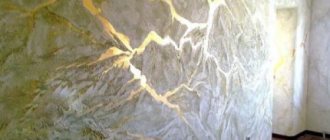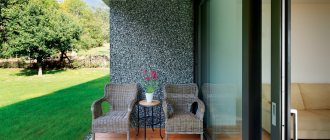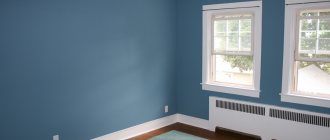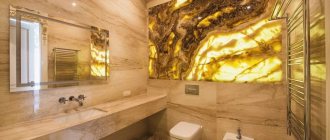Properties and features of floor travertine
Natural travertine is formed at the bottom in those areas where mineral springs emerge, carrying limestone, calcium salt and carbon dioxide.
As a result of the contact of the listed components on the surface of the source and their reaction with air, a sediment forms - calcium carbonate, that is, travertine. This natural stone has an intermediate state between limestone and marble.
It is noteworthy that the extraction of stone is a relatively simple process, since, by focusing on the surface of a reservoir, it is simply “collected”.
Rectangular tiles are most often used for floor finishing, but products are also produced in the form of large-format plates and ready-made compositions.
Travertine floor tiles are laid in the form of a mosaic or decorative panel with a pattern or design. There are several colors of the stone - milky white, cream, light gray, greenish-beige, reddish-brown.
In addition to the natural sample, the manufacturer can offer an artificial alternative. Also, in addition to flooring material, wall material is also produced, which determines the scope of application.
Very often, travertine finishing is done in a bathroom or shower, both on the walls and on the floor. In the bathroom, it can last even longer than porcelain tiles or other ceramic analogues.
The stone looks luxurious and aesthetically pleasing on the floor in the living room or kitchen, in particular on kitchen countertops or backsplashes, a good option for exterior cladding of a house.
Travertine mining
The most extensive deposits of stone are located in Germany (Stuttgart), Italy (Tivoli) and Turkey, in the area with geothermal springs Pamukkale, which is a miracle of nature. Travertine is mined in mountainous areas where there are bodies of water and volcanic activity. It occurs as a result of a chemical reaction between carbon dioxide found in thermal waters and limestone. Standing water produces a hard slab of travertine, while waterfalls and streams produce soft rock.
READ ALSO: Decorating a Bathroom with Artificial Stone - 125 (Photo) Ideas
Geologists consider travertine to be an intermediate form between marble and limestone.
Processing methods
There are many options for processing travertine flooring:
- Polishing. The products are distinguished by a mirror shine and a clearly visible stone texture.
- Semi-polished (glazed) – the tile has a smooth matte surface. The structure of the stone is clearly visible.
- Grinding. The product is characterized by a rough texture. The maximum permissible difference in relief is 0.5 mm.
- Sawing. The result is travertine with a rough, even rough, decorative layer. The permissible difference in relief is 2 mm.
- Bush hammering. The tile collection is endowed with a rough relief with a depth of no more than 5 mm.
- Brushing – artificially aged slabs using brushes.
After processing, it becomes the owner of a unique surface that imitates the natural split of stone (rock effect), artificially aged stones (antique) or natural split brushed with brushes (fur coat effect), etc.
History of appearance and main advantages
The material in question was discovered quite a long time ago, as evidenced by some buildings that have survived to this day in Europe. Extraction is carried out in quarries concentrated on the territory of numerous countries, and China, Italy and Iran are recognized as leaders in this area.
Mining is also developed in our country, but private organizations are mostly involved in this business. This factor has a positive effect on the cost, because delivery from nearby quarries is much cheaper than from abroad.
The specific composition and capacity of processing enterprises make it possible to obtain decorative items that have the following advantages:
- increased resistance to the chemical environment created by modern household detergents;
- strength and durability, which are not inferior to more popular and expensive models;
- ample opportunities for restoration with varying degrees of wear;
- a variety of textures and colors: a range of shades from light gray to dark brown, as well as a texture in many ways similar to marble - the “big brother” of travertine.
Use in domestic conditions is associated with the only drawback - the base gradually wears off and becomes matte. Those who have purchased products a long time ago usually encounter this problem, because today special polymer substances are used during processing to protect against such problems.
Advantages
Travertine in the interior is very practical and quite stable, so its installation is possible in any room, which indicates its versatility. Mechanical impacts and other loads are also not terrible - this indicates durability.
In addition, the stone, due to its natural origin, is absolutely safe and environmentally friendly. There are no chemical components or radiation residues in the composition.
Travertine floors have low thermal conductivity. This indicates a minimal probability of heat loss through the floor. This is achieved due to the dense and monolithic structure of the stone. In this case, the porous material can be used under a “warm floor” system.
Like any natural stone and ceramics, travertine is resistant to temperature and humidity changes, which makes it possible to install it in wet rooms (kitchens, bathrooms, showers, etc.).
The coating lends itself well to processing and cutting. This makes installation accessible to any non-professional. Cleaning should be done using a wrung out cloth without aggressive detergents.
Color stability is the next advantage. The decorative base will retain its natural color for a long time and will not lose it from exposure to water and ultraviolet rays.
In addition, the price of travertine is much lower than granite or marble floors - from 1,450 rubles. per square meter, and marble - from 4,000 rubles.
Application of decorative plaster Travertine
- It is recommended that the bases be properly leveled before application; ideally, the walls should be prepared as for painting. But due to the fact that the material contains a fairly large grain, you get a fairly “thick” coating layer that can hide minor unevenness in the preparation.
- since the finishing coating is relatively heavy (approximately 1.7 kg per 1 m2), a fairly large load occurs on the prepared base. In this regard, the walls must be primed with high-quality deep penetration soil. Firstly, the primer will properly strengthen the base, and secondly, it will reduce the absorbency of the substrate, which will give you the maximum opportunity to apply the layer evenly, without joints and sharp, obvious transitions. We recommend using CAP Arreghini Acrilifix. This is done so that over time nothing will peel off or fall off.
- The next step is painting with a special primer with quartz filler. When prepared, this primer gives maximum adhesion, that is, the adhesion of the base and finishing layers. Due to the fact that the soil contains quartz, the layer of decorative plaster Travertine can be applied more evenly, since the grain of the material is distributed between the grains of quartz. Unifix fine fine-grained primer with quartz filler will serve as an ideal intermediate and adhesive coating.
- at the next stage, the material itself is applied directly, that is, decorative plaster Travertine (Travertino CAP). Here you can create a pattern or texture, either with one layer or by applying two layers, it all depends on the desired result.
- and finally the final stage, this is the finishing, protective coating. As a finishing layer, either velature or special protective wax is used. Thanks to velature or wax, you can not only create a protective barrier, but you can add tint, create a glaze effect, a patina effect, antiquity, etc.
If you decide to buy Travertine decorative plaster in Moscow, if you value quality and durability, then you should definitely pay attention to a material such as Travertino CAP from the Italian factory CAP Arreghini.
Note for Travertino plaster
- when creating specific textures (including the “world map”), the application of the finishing layer of Travertine (Travertino CAP paste) must be done with one hand, that is, by the same master;
- technique for working with ready-made pasta, wet on wet;
- Unlike paints, it is more difficult to work with textured materials, so it requires skill, skill, experience, as well as knowledge of the “behavior” of the material;
- Apply finishing layers from corner to corner, without stopping;
- Experienced craftsmen should work with protective compounds, especially if they are tinted in color. Just as when painting with tinted velature or tinted wax, color inhomogeneity and spots are formed on the finishing surface, but an unknowing master will make these spots and transitions as obvious as possible.
- If you decide to buy decorative travertine plaster in a tinted form, especially if red or yellow were used among the tinting pigments, then it is recommended to use this product for its intended purpose in the next two or three weeks. As a rule, tinted compositions cannot be stored for a long time, due to the fact that lime and marble are natural materials, even in a closed container a chemical process occurs, as a result of which the color may change;
- decorative travertine plaster should be purchased with a reserve, since it is recommended to complete the work with material from one batch. There may be differences in tonality from part to part, because the base of the material is natural;
- average consumption is 1.7 kg, but depending on the texture and method of application, material consumption may increase.
Lime is a natural material that, once applied to walls, forms a hard, durable base, and the constant chemical reaction between oxygen and lime, called carbonation, makes your coating harder and more durable over the years.
Properties of decorative plaster Travertine
- Production: Italy - Cap Arreghini SpA;
- Ingredients: natural slaked lime, ground marble of various types, paste-like state, ready for use
- Base color: natural white
- Tinting: tinted according to catalogues, tinting according to individual color is possible
- Vapor permeability: high
- Pollution: low
- Grain size in paste: 1mm - 1.2mm
- Impact resistance: after 30 days
- Drying to touch-free condition: 6-8 hours, complete 24 hours.
- Application of the second layer: after 6-8 hours
- Dry weight: 70-75%
- Dilution: dilution with water is allowed to the desired working condition
- Consumption: one layer 0.85 kg/m2, two layers 1.7 kg/m2
- Temperature regime: it is advisable to work at a temperature of +5 to +25 C
- Tool: clean under water
Disadvantages of travertine
- The porous structure strongly absorbs water left on the surface for a long time, which requires treating the floor with special protective compounds. This is typical for a material whose structure is as close as possible to limestone.
- Durability is inferior to granite or marble floors;
- It is not recommended to lay tiles in areas with high traffic due to the lower density of the coating compared to other natural stones;
- Limited color range, characteristic of all natural materials.
Tile features
The tiles are made from natural stone by crushing, pressing, grinding and cutting using modern equipment. The voids created during the production process are filled with mastic. Plastic stone is easy to process.
The advantages of travertine tiles are that their surface has properties that create a pleasant feeling when used: the soft and slightly oily surface retains heat, which makes natural travertine a means of creating coziness.
Travertine is one of the most popular finishing materials for spa areas in Turkish hotels.
One of the sources of travertine is located in Turkey - Pamukkale, so historically it has developed that travertine is the most suitable material for Turkish steam rooms, where there is high humidity and a constant flow of water.
READ ALSO: Bathroom design 2020: photos of modern ideas (203 ideas)
The reasons for choosing a stone for hammams are not accidental:
- The porosity that allows the tile to absorb water ensures that it is non-slip. A stone can absorb water, and then it evaporates from it, and this does not destroy it from the inside.
- The material is thermally conductive, so it is pleasant to lie on it, but it does not overheat.
Travertine for shower
To use travertine in the shower or other high humidity areas, it is important to properly seal its pores with a suitable compound. This will prevent the rock from absorbing water and make it easier to maintain. crystallization can be done as additional protection
stone
The choice of travertine for the bathroom does not end with either the floor or the walls. This mineral is widely used in the manufacture of bathroom fixtures.
(sinks, bidets, shower trays, bathtubs), so you can make the whole bathroom out of travertine if you want..







